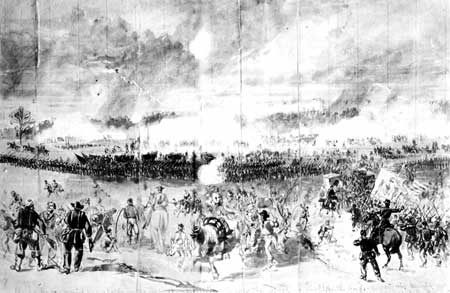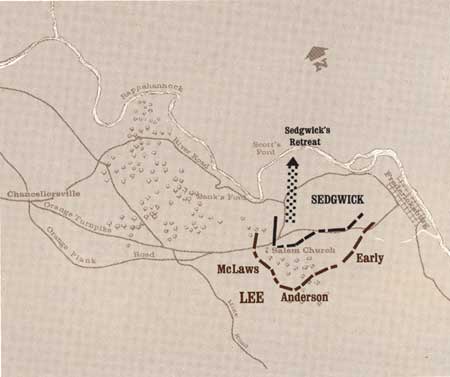|
FREDERICKSBURG and SPOTSYLVANIA COUNTY BATTLEFIELDS MEMORIAL National Military Park |
 |

Under a darkening late afternoon sky, units of
Couch's I Corps move up to stem Jackson's fierce onslaught, while
Howard's corps (foreground) flees from the field.
THE COMMANDER WHO WOULD NOT DARE
During the night the XI Corps was reorganized and held at Chancellorsville. Reynolds' I Corps, which had previously been ordered up from Fredericksburg and arrived on the field during the attack, now held the Federal right flank, with its own flank resting on the Rapidan River and facing west rather than south.
Lee's strategy was successful. The whole movement had been a model of maneuvering, screening, and massing. Yet Lee had gained little. His situation was almost as critical as when the flanking movement was being made. The Army of Northern Virginia was split into three parts, with Sickles' corps and most of Slocum's between Lee and Jackson's corps, now commanded by Stuart. Until he could reunite these two wings Lee was in danger of being destroyed piecemeal.
The Army of the Potomac had not been seriously hurt by Jackson's surprise attack. Howard's corps, though temporarily routed in panic, suffered only 2,412 casualties during the whole campaign, while Sickles' corps, for example, lost 4,119 and Slocum's 2,824. During the night Howard reorganized his men, and by morning they were ready and willing to fight, if given a chance. Moreover, with the arrival of Reynolds' corps from Fredericksburg, Hooker now had approximately 90,000 men around Chancellorsville to throw against Lee's divided 48,000. Unfortunately for the Army of the Potomac, Hooker was thinking only of defense. Strategically, most of the advantages were still his, but the Union commander had lost his nerve.

Lee turns back Sedgwick at Salem Church, May 4,
1863.
(click on image for an enlargement in a new
window)
Early the next morning Lee and Stuart resumed the assault, fighting desperately to connect with each other. Then Hooker suddenly made it easy for them. He voluntarily withdrew Sickles to strengthen his new, shorter defensive line to the north. This not only enabled Lee to unite the two wings of his army, it also gave him strategic high ground at Hazel Grove, just south of Chancellorsville, from where his artillery could inflict severe damage on the Federals. This forced Hooker to withdraw from Chancellorsville entirely into a new defensive position closer to the rivers. The Union army now arched between the Rapidan and the Rappahannock. Behind the strong defensive works that he had built, Hooker should have felt safe even though his 90,000 men were "surrounded" by Lee's 48,000.
In the meantime, Sedgwick's VI Corps had been ordered to seize Marye's Heights behind Fredericksburg from Early's division, then march to Hooker's assistance. In a daring bayonet charge, Sedgwick drove Early off the heights and back toward Richmond. Pausing only long enough to regroup, he then proceeded west on the turnpike toward Chancellorsville.
When Lee learned that Early had lost the heights and a Federal force was marching on his rear, he again boldly split his army. Showing his complete contempt for Hooker, he marched McLaws' and Anderson's divisions back toward Fredericksburg, leaving Stuart with about 25,000 men to hold the Union army of 90,000.
Late that afternoon Lee met Sedgwick's advance division near Salem Church on the Orange Turnpike and halted it, while Sedgwick waited for his other divisions to come up. The next day, May 4, Early advanced on the Federals from Fredericksburg. Attacked furiously on three sides, Sedgwick wisely abandoned any idea of joining Hooker. Instead, he gradually swung his corps around toward the Rappahannock to protect his flanks and that night crossed the river to safety at Scott's Ford, just below Banks' Ford. Hooker made no move to help Sedgwick at any time.
Lee promptly marched his weary men back to Chancellorsville to join Stuart, intending to attack Hooker again in his strongly fortified position. Fortunately for the exhausted Confederate troops, the Army of the Potomac retreated across the Rappahannock before Lee could mount another assault. The battle of Chancellorsville was over. The Union loss in killed, wounded, and missing totaled 17,287; the Confederate, 12,821.

|
|
Last Modified: Mon, Dec 2 2002 10:00:00 am PDT |


